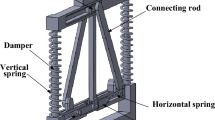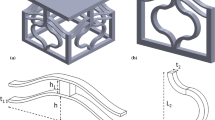Abstract
The sheet current model considering the end effects is applied to design a six-degree-of-freedom (6-DOF) active vibration isolation system (AVIS) driving by the voice coil motors (VCMs). Compared with the charge model, the sheet current method represents higher calculation efficiency. Then, the hybrid functions (HFs) are employed to identify the multi-input and multi-output (MIMO) AVIS, and the identification parameters are used to design the controller. To promote the control performance, the composite nonlinear feedback (CNF) controller is designed based on the identification parameters. Consequently, the simulations and experiments are carried out, compared with PID controller, the CNF controller shows quicker response and smaller overshoot, i.e., the CNF controller achieves the dynamic damping ratio during the control. Thus, the experimental results demonstrate the better performance of the CNF controller.
Similar content being viewed by others
Abbreviations
- B :
-
Magnetic flux density (T)
- μ 0 :
-
The permeability of the vacuum
- M :
-
Homogeneous magnetization (A/m) r 0
- \(\overrightarrow{A}\) :
-
Magnetic vector potential
- I :
-
Current (A)
- L :
-
The length of wire (m)
- K 0 :
-
Sheet current density (A/m)
- S (m) :
-
M-set sample-hold-functions
- T (m) :
-
M-set triangular functions
- ξ :
-
The damping ratio
- ω n :
-
The natural frequency (Hz)
References
T. Markus, S. Rudolf, S. Andreas, H. Reinhard and S. Georg, Six degree of freedom vibration isolation platform for in-line nano-metrology, IFAC, 49 (21) (2016) 149–156.
E. Csencsics et al., Mechatronic design of an active two-body vibration isolation system, IFAC, 49 (21) (2016) 133–140.
W. Lei, L. Junzhong, Y. Yuanyuan, W. Jing and Y. Jiangbo, Active control of low-frequency vibrations in ultra-precision machining with blended infinite and zero stiffness, International Journal of Machine Tools and Manufacture, 139 (2019) 64–74.
Y. Zhang et al., Dynamic analysis and control application of vibration isolation system with magnetic suspension on satellites, Aerospace Science and Technology, 75 (2018) 99–114.
A. Abbasi, S. Khadem and S. Bab, Vibration control of a continuous rotating shaft employing high-static low-dynamic stiffness isolators, Journal of Vibration and Control, 24 (4) (2018) 760–783.
S. M. M. Mofidian and H. Bardaweel, Displacement transmissi-bility evaluation of vibration isolation system employing nonlinear-damping and nonlinear-stiffness elements, Journal of Vibration and Control, 24 (18) (2018) 4247–4259.
X. Wang, F. B. and H. Du, Reduction of low frequency vibration of truck driver and seating system through system parameter identification, sensitivity analysis and active control, Mechanical Systems and Signal Processing, 105 (2018) 16–35.
J. Orivuori, I. Zazas and S. Daley, Active control of frequency varying disturbances in a diesel engine, Control Engineering Practice, 20 (11) (2012) 1206–1219.
G. Shan et al., Experimental characterization, modeling and compensation of rate-independent hysteresis of voice coil motors, Sensors and Actuators A: Physical, 251 (2016) 10–19.
J. H. Lee et al., Control of a hybrid active-passive vibration isolation system, Journal of Mechanical Science and Technology, 31 (12) (2017) 5711–5719.
A. R. Insinga et al., Performance of halbach magnet arrays with finite coercivity, Journal of Magnetism and Magnetic Materials, 407 (2016) 369–376.
B. Shen et al., Optimization study on the magnetic field of superconducting halbach Array magnet, Physica C: Superconductivity and its Applications, 538 (2017) 46–51.
T. Zhu et al., Vibration isolation using six degree-of-freedom quasi-zero stiffness magnetic levitation, Journal of Sound and Vibration, 358 (2015) 48–73.
N. Alujević et al., Stability and performance limits for active vibration isolation using blended velocity feedback, Journal of Sound & Vibration, 330 (21) (2011) 4981–4997.
N. Alujević et al., Passive and active vibration isolation systems using inerter, Journal of Sound and Vibration, 418 (2018) 163–183.
M. E. Hoque et al., A three-axis vibration isolation system using modified zero-power controller with parallel mechanism technique, Mechatronics, 21 (6) (2011) 1055–1062.
A. Siami et al., Parameter optimization of an inerter-based isolator for passive vibration control of Michelangelo’s Rondanini Pietà, Mechanical Systems and Signal Processing, 98 (2018) 667–683.
M. H. Kim et al., Design and control of a 6-DOF active vibration isolation system using a halbach magnet array, IEEE/ASME Transactions on Mechatronics, 21 (4) (2016) 2185–2196.
Z. Lin, M. Pachter and S. Banda, Toward improvement of tracking performance nonlinear feedback for linear systems, International Journal of Control, 70 (1) (1998) 1–11.
B. M. Chen et al., Composite nonlinear feedback control for linear systems with input saturation: theory and an application, IEEE Transactions on Automatic Control, 48 (3) (2003) 427–439.
T. W. Li, Analysis of flat voice coil motor for precision positioning system, International Conference on Electrical Machines & Systems, IEEE (2011).
A. Deb et al., A new set of piecewise constant orthogonal functions for the analysis of linear SISO systems with sample-and-hold, Journal of the Franklin Institute, 335B (2) (1998) 333–358.
A. Deb, A. Dasgupta and G. Sarkar, A new set of orthogonal functions and its application to the analysis of dynamic systems, Journal of the Franklin Institute, 343 (1) (2006) 1–26.
S. Roychoudhury, A. Deb and G. Sarkar, Analysis and synthesis of homogeneous / non-homogeneous control systems via orthogonal hybrid functions (HF) under state space environment, Journal of Information and Optimization Sciences, 35 (5-6) (2014) 431–482.
Z. H. Jiang and W. Schaufelberger, Block Pulse Functions and Their Application in Control System, Springer, Berlin (1992).
Acknowledgments
This work is partially supported by the Science Challenge Project (Grant No. JCKY2016212A506-0105) and the National Natural Science Foundation of China (Grant No. 11802279).
Author information
Authors and Affiliations
Corresponding author
Additional information
Recommended by Editor No-cheol Park
Pinkuan Liu is a Professor of School of Mechanical Engineering, Shanghai Jiao Tong University, Shanghai, China. He received his doctoral degree in Mechanical Engineering from Harbin Institute of Technology. His research interests are precision mechatronic engineering and ultra-precision machining.
Rights and permissions
About this article
Cite this article
Jiang, D., Li, J., Li, X. et al. Modeling identification and control of a 6-DOF active vibration isolation system driving by voice coil motors with a Halbach array magnet. J Mech Sci Technol 34, 617–630 (2020). https://doi.org/10.1007/s12206-019-1208-y
Received:
Revised:
Accepted:
Published:
Issue Date:
DOI: https://doi.org/10.1007/s12206-019-1208-y




